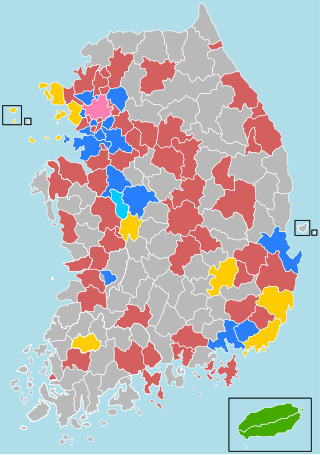Top Qs
Timeline
Chat
Perspective
List of cities in South Korea
From Wikipedia, the free encyclopedia
Remove ads
The largest cities of South Korea have an autonomous status equivalent to that of provinces. Seoul, the largest city and capital, is classified as a teukbyeolsi (Special City), while the next six-largest cities are classified as gwangyeoksi (Metropolitan Cities). Smaller cities are classified as si ("cities") and are under provincial jurisdiction, at the same level as counties.
This article needs additional citations for verification. (July 2020) |

Special city
Special autonomous city
Metropolitan cities
Big municipal cities
Administrative cities
Cities
Remove ads
City status
Article 10 of the Local Autonomy Act defines the standards under which a populated area may become a city: an area which is predominantly urbanised and has a population of at least 50,000; a gun which has an urbanised area with a population of at least 50,000; or a gun which has a total population of at least 150,000 and multiple urbanised areas each with a population of at least 20,000.[1] Cases outside of these standards require specific legislation, such as the special bill by the National Assembly to designate Gyeryong as a city.[citation needed]
Under Article 3 of the Local Autonomy Act, a city with a population of less than 500,000 may create administrative subdivisions in the form of dong in its urbanised area and eup or myeon in its rural area, while a city with a population of more than 500,000 may create administrative subdivisions in the form of non-autonomous gu.[2]
Remove ads
Classifications for large municipal cities
Summarize
Perspective
The national government can designate cities of at least 500,000 inhabitants as special status cities. This status expands the scope of administrative authority delegated from the provincial government to the city government.[3] There is no legal standard for becoming a metropolitan city, but it was usually promoted to a metropolitan city when the population was close to 1,000,000. However,there are four cities in Suwon, Changwon, Goyang, and Yongin that have a population of more than 1 million but have not become metropolitan cities, there is no further promotion.[citation needed]
Big city
A big city is a city (other than a special city or a metropolitan city) that has a population greater than 500,000, and has been designated by an order of the national government under Article 198 of the Local Autonomy Act. Big municipal cities are given the power to subdivide themselves into non-autonomous districts (Korean: 일반구; Hanja: 一般區).[3] However, some big municipal cities have chosen not to divide themselves into districts, such as Bucheon, Gimhae, Hwaseong, or Namyangju. Currently, South Korea has a total of 17 big cities. "Specific city" (특정시; 特定市) is an unofficial term for big city with municipal status.[citation needed]
Due its legal status as an administrative city, Jeju City cannot be designated as a "big city" under the Local Autonomy Law, despite having an estimated population exceeding 500,000 as of 2022. The designation of "administrative city" was created by the law which granted special self-governing status to Jeju Province; that law specifically states that the Local Autonomy Act would not apply to administrative cities. As such, Jeju City does not enjoy special autonomy and only has the same legal powers as the much smaller Seogwipo. The administrative authority of Jeju City is trying to expand the scope of administrative authority delegated from the provincial government to the city government.[4]
Special-status city
A special-status city is a subclass of big municipal city that has a population greater than 1,500,000.
Remove ads
List
- Notes
- The name "Seoul" does not originate from hanja. The official Chinese translation is written as 首爾/首尔, which is a transcription based on the pronunciation of "Seoul" in Mandarin variant of Chinese language, and thus is not hanja of Korean language. In old Chinese documents, 漢城/汉城 was used. As an affix or abbreviation, the character gyeong (京), which means "capital", is used.
- Seoul was designated a "Special Independent City" (Teukbyeol-jayusi; 특별자유시; 特別自由市) separate from Gyeonggi Province on August 16, 1946; it became a "Special City" on August 15, 1949.
Remove ads
Cities by population
Summarize
Perspective
This is a list cities of South Korea by population including provincial-level divisions: special city (특별시/特別市) and metropolitan cities (광역시/廣域市), and municipal-level division: cities (시/市). Other municipal-level divisions: counties (군/郡 which have populations under 50K) and districts (구/區) are not included. All population data are based on the South Korean population and housing census 2000–2020.[5]
Remove ads
Renamed cities
Remove ads
Dissolved cities
Remove ads
Claimed cities
Remove ads
Gallery
See also
References
Sources
External links
Wikiwand - on
Seamless Wikipedia browsing. On steroids.
Remove ads







